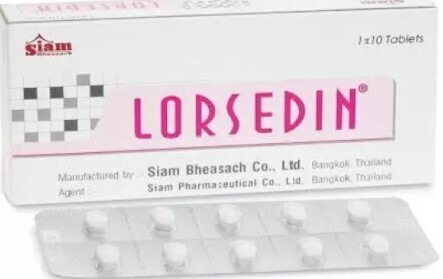Lorsedin (Loratadine) 10mg
Home/Store/BCX-i Pharmacy ဆေးနှင့်ဆေးပစ္စည်များ/ဆေးအမျိုးအမည်များ Products of Medicine/Nasal decongestant, Sorethroat, Cough suppressant and mucolytic နှာစေး၊ လည်ချောင်းနာ၊ ချောင်းဆိုး၊ ချွဲပျော် အတွက်ဆေးများ
Ks1,500.00
Selling by
In stock: 20 available
Product Details
အသက် ၁၂ နှစ် အထက် နှာမွှန်ခြင်း၊ အလာဂျစ် ဖြစ်ခြင်း၊ယားယံခြင်း တို ့အတွက် တနေ ့၁လုံးခန် ့သောက်သုံးနိုင်ပါသည်။ (Unicode)
အသက္ ၁၂ ႏွစ္ အထက္ ႏွာမႊန္ျခင္း၊ အလာဂ်စ္ ျဖစ္ျခင္း၊ယားယံျခင္း တို ့အတြက္ တေန ့၁လံုးခန္ ့ေသာက္သံုးႏိုင္ပါသည္။ (Zawgyi)
Generic Medicine Info
|
Indications and Dosage
Oral
Allergic conditions
Adult: 10 mg once daily or 5 mg bid.
Child: 2-12 years <30 kg: 5 mg once daily; >30 kg: 10 mg once daily. >12 years Same as adult dose. |
||||
|
Renal Impairment
|
||||
|
Hepatic Impairment
Severe: Initially, 10 mg every other day.
|
||||
|
Administration
May be taken with or without food.
|
||||
|
Special Precautions
Severe hepatic and renal impairment. Children. Pregnancy and lactation.
|
||||
|
Adverse Reactions
Significant: Headache, somnolence, drowsiness, fatigue, nervousness.
Cardiac disorders: Palpitation, tachycardia, hypotension. Gastrointestinal disorders: Dry mouth, abdominal pain, nausea, vomiting, diarrhoea, gastritis. General disorders and admin site conditions: Malaise. Hepatobiliary disorders: Jaundice, hepatitis, hepatic necrosis. Investigations: Elevated liver enzymes, weight gain. Metabolism and nutrition disorders: Increased appetite. Nervous system disorders: Dizziness. Skin and subcutaneous tissue disorders: Rash, alopecia. |
||||
|
Patient Counseling Information
This drug may cause dizziness, if affected, do not drive or operate machinery.
|
||||
|
Overdosage
Symptoms: Somnolence, tachycardia, drowsiness, headache. Management: Symptomatic and supportive treatment. May administer activated charcoal and may perform gastric lavage.
|
||||
|
Drug Interactions
May increase plasma concentrations with ketoconazole, fluconazole, erythromycin, clarithromycin, cimetidine.
|
||||
|
Food Interaction
Food delays time to peak plasma concentration and increases bioavailability. Increase risk of CNS depression with alcohol.
|
||||
|
Lab Interference
May diminish the wheal and flare reactions to skin test antigens.
|
||||
|
Action
Description: Loratadine, a piperidine derivative, is a long-acting, non-sedating antihistamine which selectively inhibits histamine H1-receptors on effector cells.
Onset: 1-3 hours. Duration: >24 hours. Pharmacokinetics: Absorption: Rapidly and well absorbed from the gastrointestinal tract. Food delays time to peak plasma concentration and increases bioavailability. Time to peak plasma concentration: Approx 1-1.5 hours (loratadine); approx. 1.5-3.7 hours (desloratadine). Distribution: Enters breast milk. Volume of distribution: 119 L/kg. Plasma protein binding: Approx 97-99% (loratadine); approx 73-76% (desloratadine). Metabolism: Extensively undergoes first-pass metabolism in the liver via CYP2D6 and CYP3A4 to desloratadine as the active metabolite. Excretion: Via urine (40%); faeces (approx 40% as metabolites). Elimination half-life: 8.4 hours (loratadine); 28 hours (desloratadine). |
Display prices in:MMK
